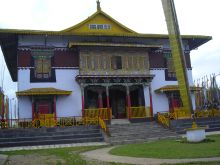 Places To Visit In Pelling Links
Places To Visit In Pelling LinksPemayantse Monastery Pelling Information

Located around 02 kms away from Pelling town, Pemayantse Monastery, the second largest and one of the oldest monasteries in Sikkim holds the highest regard and belonging to to ngingma Sect ( one of the four sects of Tibetan Buddhism). Around 108 monks who belong to Bhutia families of Sikkim are residing here.
Pemayantse Monastery was built in the year of 1706 AD by Gyalwa Lhatsun Namkha Jigme, the main amongst three monks who consecrated the first religious King of Sikkim in Yuksom in 1642 AD. Since 1950, it has got modern construction touch with new form of building materials like steel, cement etc.
Pemayantse Monastery is regarded the most important and the nuclei of monasteries in Sikkim as it was meant only for “ Ta-sang” lamas ( Pure Monks), thus monks of pure Tibetan race, celibate and without any physical deformities. Pemayantse Monastery draws religious sustenance from Mindoling Monastery in Central Tibet.
Pemayantse Monastery boasts of a splendid collection of ancient Buddhist antique idols, scriptures as well as sculptures. On the top floor of the monastery there is an amazing seven tiered wooden sculpture depicting the Maha Guru’s Heavenly Palace “ Zadong Phalri “ – complete with rainbows, angles and whole panoply of Buddhas and Bodhisattvas. This master piece was single handedly completed by the late Dunzing Rimpoche in 5 yrs.
The main festival of the monastery is the “Chaam” or “ Masked Dance”, where the lamas also take part in the dance and dress up in the beautiful costumes to represent “Mahakala” and “Guru Drag-dmar”, is celebrated on the 28th or 29th day of the 12th month of the Tibetan Calendar, which normally correspondence to the month of February. The dance comes to end on the third day with the unfurling of the “ Ghyo-ku” – a gigantic embroidered Buddhist scroll as the devotees pay their homage.
From the Pemayantse Monastery excellent view of Mt. Kanchenjunga and other snow capped mountains with the bird’s eye view of Rabdantse ruins are really exiting.
0 min read
 Back to Previous Section
Back to Previous Section